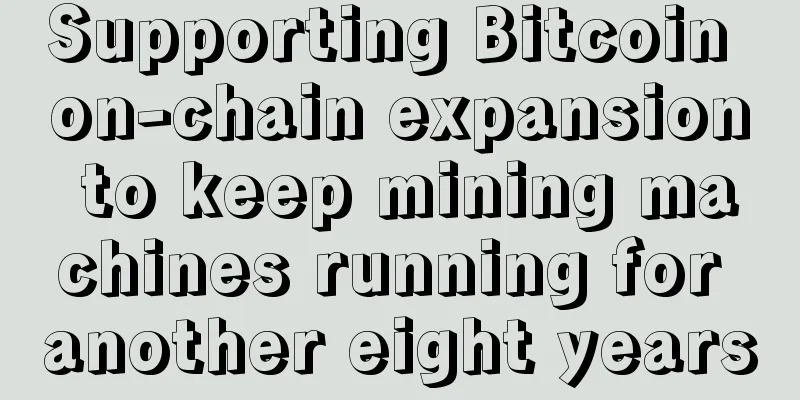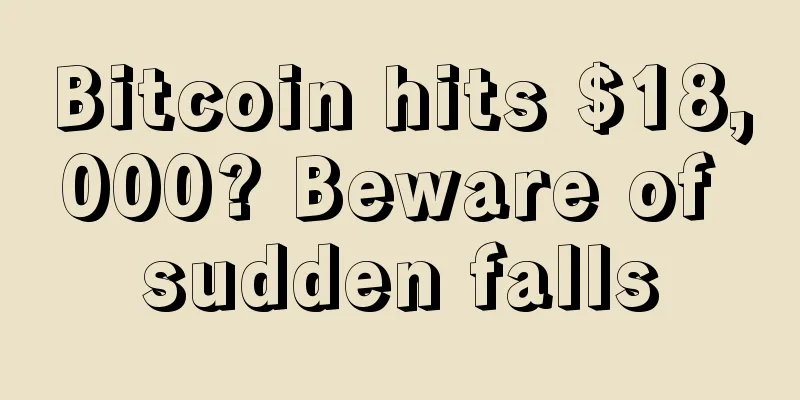Supporting Bitcoin on-chain expansion to keep mining machines running for another eight years

Chapter 0 IntroductionThis article is the PPT and speech manuscript of my speech at the Chengdu Miners Conference. Chapter 1 How is the mining business?Most of you here are miners or people working in the mining industry. Let me ask you a question first: how many years do you plan to mine? Two years? Five years? Ten years? Fifty years? Does anyone tell me the answer? I like Bitcoin very much, and I hope the mining machine I bought today can mine for eight years!!!
So let’s take a look at what the Bitcoin mining business is like.
The total network computing power and block rewards are things that we as individual miners cannot influence or change. The sunk cost of purchasing mining machines cannot affect the revenue of our mining business because the money has already been spent and we have no other options. Now all that’s left are the block fee income, Bitcoin price, mining operating costs, and the mining life of the mining machines. Are these four things that we miners can do the work? The higher the price of Bitcoin, the more profitable mining becomes. The lower the operating costs, the more profitable mining is. The longer the life of the mining machine, the more profitable the mining will be. The more block fees there are, the more profitable mining is. These are also the four factors that we as miners should focus on. Today's topic also needs to exclude the factor of operating costs, which include electricity bills, consumables, employee salaries, etc. It is best to ask your own engineers about this. What I want to talk about today is that we have a method that can create a better environment for the price of Bitcoin, provide more growth potential for block transaction fees, and extend the life of mining machines. That is capacity expansion. Moreover, the decision on capacity expansion lies in the hands of everyone here. It is you who decide whether you can simultaneously increase the price of Bitcoin, increase transaction fee income, and extend the life of the mining machine. Chapter 2: Capacity Expansion Increases Miner Fees Let us first explain the relationship between capacity expansion and transaction fee income. This is the current situation of the Bitcoin blockchain. Currently, the size of a Bitcoin block is 1M, and the size of a Bitcoin transaction is basically between 225 bytes and 500 bytes. A block can accommodate at most 3,500 transactions. This is the current limit of Bitcoin's transaction volume. In fact, only 3 transactions can be processed per second. The chart below shows how many transactions a block contains in the past two years. This data has been growing steadily in the seven years since the release of Bitcoin. But now it is very obvious that the number of transactions in a single block has stopped growing in the past six months. The reason is that as you can see from this picture, this is the median block size, and we are already full. We can't grow any further. The following chart shows the average daily transaction fees received by miners in the past two years. On average, miners can now receive 59 coins in fees per day. If you have 1% of the total network computing power, which is 17P of computing power, you can receive 0.59 coins in fees per day. Currently, the block reward for a block is 12.5 BTC, and the block reward income that a miner can receive in a day is 1,800 BTC. The proportion of transaction fees in the miner’s income is still very small, averaging only 3%. The current situation is that because the block size is limited to 1M, the number of transactions that can be accommodated in a block is limited, so the total amount of transaction fees is difficult to increase. The block reward is fixed. But what’s even more tragic is that computing power is still increasing. What does this mean? In an industry, the total revenue is fixed and cannot be increased. However, the number of employees keeps increasing, and the competition is getting worse. The final result is that everyone can only get an average profit. This kind of business is difficult to do. Can we increase the transaction fee? The answer is that it is difficult, and the amount that can be increased is very low. If the fee is increased, fewer people will use Bitcoin. This is a basic economic law. There is no reason why I must use Bitcoin. The overall fee can only be increased to a level that most people don't care about. For example, a transaction of a few cents. Can we wait for the price of Bitcoin to rise? The answer is that the outlook is unclear. From the basic economic law, the price is determined by demand and supply. Now the supply of Bitcoin is fixed, but the demand comes from people who use Bitcoin. And because the 1M block limits the performance of Bitcoin, it will definitely constrain the demand for Bitcoin. Therefore, the underlying logic does not support a significant breakthrough in the price of Bitcoin under the current predicament. What else can we do? The answer is: expansion. We can expand the Bitcoin block from the 1M limit and no longer restrict user usage. We welcome as many people as possible to use it. Let's do a mathematical inference. If in the next eight years, the Bitcoin block is filled to 1G, which is 1,000 times the current size, how much will the miners earn? The average daily miner income for a 1M block is 59 BTC, which is 1,000 times the amount, 59,000 BTC, which is more than the block reward. If you have 1% of the computing power of the entire network, your income is 590 BTC. What will the price of Bitcoin be at that time? Undoubtedly, the price will be much higher than it is now, because the usage has greatly increased and Bitcoin has become more popular. The life of the mining machine will also be longer, because more mining will be done, and the price will be higher. The computing power will be more valuable. If the Bitcoin block is filled to 1G, I believe that the Antminer S9 mining machine you bought now will definitely still be mining, even if the computing power of the entire network has increased by 1,000 times. Because the price of Bitcoin has definitely increased by more than 1,000 times. Regarding the expansion of capacity, there is a little story here. At the beginning of this year, Chinese miners and Bitcoin Core developers held a discussion on block size in Hong Kong. The discussion was very ideal, and everyone advocated expansion. Among us who were listening to the live broadcast, a large number of people went to the futures market to open long orders. At that time, in a WeChat group, many people were posting long orders. As a result, the price really went up. There is another little story. At the end of August, Chinese miners’ representatives went to the United States to discuss the block expansion with Core developers. The result was terrible. The developers refused to expand the block. When the news came out, the market fell. Another story is that when Bitcoin Unlimited received $500,000 in support, the price of Bitcoin went up by $100. When Viabtc directed its computing power to Bitcoin Unlimited, the price also went up. Of course, we still have to state that there are many factors that affect prices. Bitcoin is now a news market, and the expansion news only affects the spot price through the news market. This is mainly due to speculators, rather than an increase in the real demand for Bitcoin. Chapter 3: Capacity Expansion to Extend Mining Machine LifeI would like to ask everyone a question, why is the lifespan of Bitcoin mining machines so short? Don’t you think this is a very strange thing? No industry has such a short lifespan of production equipment as Bitcoin! I am a mechanical designer. The best machining equipment I have ever used is a four-axis five-motion turning and milling machine, which is very elegant. But the simplest and most crude machine tools on the market are still in use. They are lathes imported from the Soviet Union in the 1950s. The power consumption, consumables cost, and labor cost of this broken machine tool are much higher than those of the four-axis five-motion. The efficiency is also much lower. This technology is separated by dozens of generations! But it has not been scrapped. The tool my mother uses for farming is a hoe, which was invented during the Spring and Autumn Period and the Warring States Period. It has been more than 2,000 years and is still in use. Why can't the most advanced equipment in the farming industry force this 2,000-year-old technology out of the market? Why can these two types of production equipment with infinitely different efficiencies appear on the market at the same time? Let's look at our computers and mobile phones. When I went through security at Shenzhen Bao'an Airport yesterday, their computer monitors were still CRTs. I guess many people born after 2000 have never heard of this type of monitor. I bought this laptop four years ago, and my iPad is iPad 2, which are both 6 years old. Why can they still be used? In the medical industry, why does traditional Chinese medicine, which was practiced hundreds of years ago, still have a market today? Why hasn't modern medicine eliminated traditional Chinese medicine? Why are mining machines that are only a year old going to be eliminated? Have you ever wondered why? Why is the life of mining machines so short? Isn’t this a very strange thing? The reason is that mining revenue is deterministic, clearly calculable, and without any randomness, just the block reward. Once the mining machine manufacturer calculates, as long as I produce so many mining machines and my performance is so good, I can get almost all the profits, and my competitors will all be left with nothing. So he will work hard to beat his opponents first. The mining machine manufacturer developed a new mining machine, and then calculated it himself. He saw that if I produce 10,000 units, all the newly mined coins on the entire network will be mine. So he will work hard to produce. That's it. When the latest mining machine appears, all the old mining machines are knocked down. In any industry, the revenue is clear, and under the premise of no randomness, the market will be monopolized by the most advanced production equipment. Will the life of Bitcoin mining machines be so short in the future? In the future, the block rewards will be less and less. If the total amount of handling fees can be increased, the life of the mining machine can be extended. The total amount of handling fees is not as clear as the block reward. But the obstacle is the limit of block size. If the 1M block size limit is still there, the life of the mining machine will still be short. If we develop agriculture, we stipulate that only three acres of land in the world can be used for agriculture every second. Just three acres. If it exceeds three acres, a hard fork will occur. Then the most advanced equipment will definitely kill the backward equipment in seconds. If we are engaged in industry, and stipulate that the world can only process three tons of steel per second, just three tons, if it exceeds three tons, a hard fork will occur, then the most advanced machine tools will definitely kill the backward equipment in seconds. If the Internet stipulates that the root domain name node can only be accessed three times per second, then there are only three times. If it exceeds three times, a hard fork will occur. Then old computers that cannot compete with the Internet speed will definitely be eliminated long ago. What would happen if it was stipulated that the medical industry could only treat three patients per second worldwide? If it exceeded three times, a hard fork would occur. The Bitcoin block size is limited to 1M, and only three transactions can be processed in one second. If the block size limit is lifted, the number of people using Bitcoin will not be artificially restricted. As Bitcoin develops, there will be more and more users, and the price of Bitcoin will become higher and higher. Miners will receive more transaction fees, and the proportion of transaction fees in miners' income will be higher. It will also be impossible for the latest mining machine manufacturers to carry out brutal massacres of old mining machines, and the life of mining machines will be longer. Chapter 4: Blockchain Expansion Makes Bitcoin $100,000Now let’s ask the fifth question: Can the price of Bitcoin really reach $100,000 in the future? Currently, there are only millions of Bitcoin users, and the price is a few thousand yuan, or a few hundred dollars. To reach $100,000, the number of users must increase to hundreds of millions. The factors that influence the price are too complex, but we can look at the number of Bitcoin users from the scale of the Bitcoin network, and we can also roughly infer the price potential of Bitcoin. Can you imagine how niche the current Bitcoin network is? We now have 6,000 full nodes, most of which are running on Alibaba Cloud, Tencent Cloud, and Amazon Cloud. How many of us use light wallets, and how many people use a mobile phone to install a Bitcoin wallet? 100,000? 1 million is the limit. And we have even fewer miners. There are more than a dozen large mining pools around the world, running mining nodes. What a small network this is. Have you ever thought about how this network structure can develop? For example, can we expand the number of full nodes to 1 million on this network structure? Or can we expand the number of SPV wallets to 10 million? I don't think so. Let's assume that there are 10 million SPV wallets in the United States, but only 1 million SPV wallets in China and only 10,000 SPV wallet nodes in Africa. Then everyone initiates transactions on the same Bitcoin blockchain. A large number of transactions from the United States come to us, but we only have a few transactions. And our network structure is still the current pure peer-to-peer network. Can such a network work properly? No, it will collapse. Such a blockchain will definitely fork. In fact, the Bitcoin network has crashed once. It was at the end of 2015. It was due to a Bitcoin transaction scalability attack, and someone launched a large number of stress tests on the Bitcoin network at that time. A large broadcast storm appeared on the network, and almost all Bitcoin wallets crashed at that time, and transactions could not be confirmed. At that time, the customer service of each transaction was very annoyed, and they kept answering calls. Customers asked, "Ah, why hasn't my recharge been credited yet?" One day, one of my wallets suddenly received more than a dozen transactions. These were rewards sent to me by several people in a month. At that time, they could not be confirmed, and were finally packed up by a miner at one time. Currently, our Bitcoin network structure is very fragile and cannot be expanded on a large scale. The price of such a network cannot rise to $100,000. But think about what the Internet is like. It is the Internet we use every day. Each of us has more than one computer. I have two, a desktop and an Apple laptop. Most of us have more than one mobile phone. I have three mobile phones, an Apple, a Xiaomi, a Nokia, and an iPad. There are also a large number of servers, super data centers, and a large number of routers and switches on the Internet. We also have countless sensors connected to the Internet. There are more than tens of billions of connected devices on the Internet. That is much more than our population. Compared with the Internet, our current Bitcoin network is such a pitifully small network. But what about the future? The future looks like this: The entire Bitcoin network will have a large number of light wallet nodes, the number will exceed 100 million, there will be a large number of complete nodes that have been cut by Satoshi Nakamoto, there will be a large number of complete nodes running in super data centers, there will be a large number of Bitcoin transaction routers and Bitcoin transaction switches like today's routers and switches, and finally, the most important thing is the mining nodes built by everyone present. The number of devices in this network will exceed 10 billion. And the most important thing is that everyone present is a miner. The responsibilities of miners are as important as the root domain name server of the current Internet. It is the most basic service to ensure the safe operation of the entire network. What will the price of Bitcoin be by then? $100,000? Come on, it will start at $1 million. But today we have to work hard for this network, now we have to work hard to promote the construction of this network, and what we have to do now is to expand the block capacity and remove the 1M block limit. What can a 1M block do? That is, the most important mining node can only pack 3 transactions per second on average. On average, 3 transactions per second. The foundation of this network can only do 3 things per second. What scale of network can it grow into? Can you imagine that the root domain name node of the Internet can only be accessed three times a second? With this 1M block limit, we are just a small and lonely player. Other industries look at us and think we are just playing house. We must expand the block capacity, otherwise we will not be able to reach $100,000. Otherwise, mining will be just a game of playing house. Chapter 5: Let’s not talk nonsense, what should we do now?So what do we need to do now? What miners need to do is not complicated, and this choice is not difficult at all. All you need to do is to direct your computing power to the mining pool that supports expansion. Currently, there are two mining pools that explicitly support and run Bitcoin Unlimited in production: Bitcoin Jesus, Roger Ver’s bitcoin.com mining pool, and the Chinese-run Viabtc mining pool. These two mining pools together account for 10 to 15% of the computing power. There are other mining pools that have expressed their support for capacity expansion, but have not taken any actual action, and are just continuing to use Bitcoin core out of inertia. Almost no mining pool has said it refuses to expand capacity. Direct your hashrate to the V-pool that supports expansion. That's it. So easy. There is a question. You may say, I only have a few terabytes of computing power and a few mining machines. If I point it to the V pool, will it work? Chapter 6 When Will We SucceedThere is a law of communication in communication studies. This is the picture In our society, 2.5% of people are innovators (leaders). 13.5% of people are early adopters (followers or loyal employees). The next 34% are the majority of early adopters (people who are more willing to accept new things), followed by the majority of late adopters (ordinary people) and the minority of people who take action at the end. These people are out of touch with the mainstream of society (people out of touch with society). In communication studies, this point at the end of 13.5% is called the tipping point. As long as an idea or a product has a market share of 13.5%, that is, you must occupy 17% of the market, then this idea will instantly spread to the entire society and spread to the end of the next 34%, which accounts for 84% of the entire society. If a product's market share exceeds 17%, then you can instantly achieve an explosion in market share, even reaching 84%. This is called the communication tipping point. Just like Darwin's theory of evolution, when Darwin came up with it, few people believed in it at first. Only Darwin and Wallace believed in it. Others scolded them, saying that their ancestors evolved from monkeys. During that period of history, evolution was not popular. If a teacher in an American school taught evolution, he would be sued. It was called the Monkey Act. But history slowly wore away, and the number of people who believed in evolution slowly wore away the tipping point of 13.5%. After that, there was no resistance, and no one scolded you that your ancestors evolved from monkeys anymore, and no one sued the teachers who taught evolution. Everyone accepted it. In fact, most people didn't know what evolution meant, and had no idea about the details of how nature was selecting traits and genes. Now someone has taken the lead in block expansion. In terms of block expansion, we have already passed the 2.5% point. But where are we now? Right here, only 10%. We just need to work harder to push the actual support for expansion to this point, that is, 16%, and we will reach the tipping point. Then the whole market will be detonated, and we can quickly reach more than 80% of the computing power support. The last 16% of the computing power will have to be switched over. So what we need to do now is to find another 6% of computing power, which is about 150P computing power to actually support capacity expansion. Then the overall situation will be determined soon. Or the miners present here can direct their own computing power to the Viabtc mining pool and push Viabtc's computing power to a stable level above 16%. We can then quickly gain the basic network strength that can be expanded into a network on par with the current Internet in the future. This process may be difficult. Others will scold us, saying that we are blocking the development of Bitcoin by expanding the capacity and that we do not support Segregated Witness. If you go to the 8btc forum, you will know how exciting this debate is. I don’t dare to post there now. If I do, I will be scolded to death. Don’t pay attention to them. They are people who don’t want to believe that they are monkeys. We insist on Bitcoin and mining for another eight years. Whether our mining machines can continue to mine for us for another eight years depends on this one move. Everyone here, it depends on you. Okay, my speech is over. |
<<: Coin Zone Trends: Bitcoin Price Trends Based on Big Data This Week (2016-10-24)
>>: Bitcoin remittance company Coins receives $5 million in Series A funding
Recommend
Analysis of women's poor face shapes. Do women with cone-shaped faces look poor?
If a person is the very poor type, then we may on...
What parts make others lose confidence in you?
What parts make others lose confidence in you? It...
Mole physiognomy shows those people with happy marriages
Many people believe that marriage is the grave of...
What are the facial features that a boss should have?
In today's great era, everyone wants to be th...
Do you know what fate a woman with high cheekbones and brow bones represents?
Women with high cheekbones will actually be seen ...
Ebang International's IPO application failed, and the three major mining machine manufacturers all failed in their IPO journey
Financial News on June 21, 2019: According to the...
What kind of people are prone to trouble?
What kind of people are prone to trouble? Right a...
Will the next bull market opportunity be triggered by blockchain being brought under regulation?
2022 is almost over, and one can’t help but look ...
Does a man with a high forehead have a bad relationship with his parents? Why?
Some people have a very good relationship with the...
What kind of people will have great ups and downs in their fate?
Even if a person does not become rich and powerfu...
What kind of face will show good fortune? A rich income and a wealthy life
Although money is something outside of our body, ...
Zhong Yi said: Teach you three ways to tell which leader is not worth following!
I believe that everyone often encounters speechle...
Which mole on a girl is bad for marriage?
Which mole on a girl is bad for marriage? Mole on...
What kind of woman has a beautiful face but a tragic fate?
What kind of woman has a beautiful face but a tra...
What is a dragon nose? Is it good to have a dragon nose?
Everyone has a nose, but not everyone's nose ...









